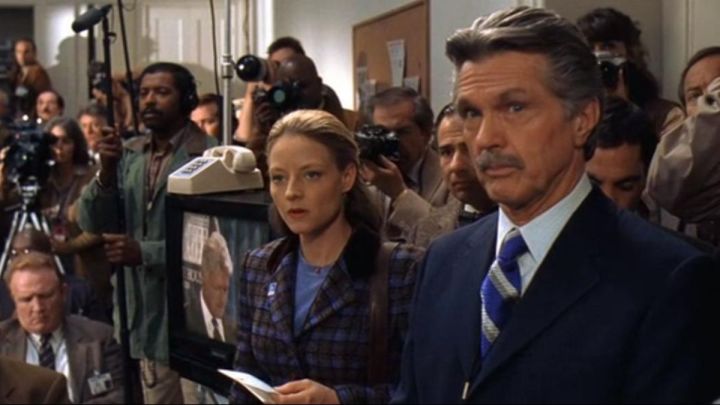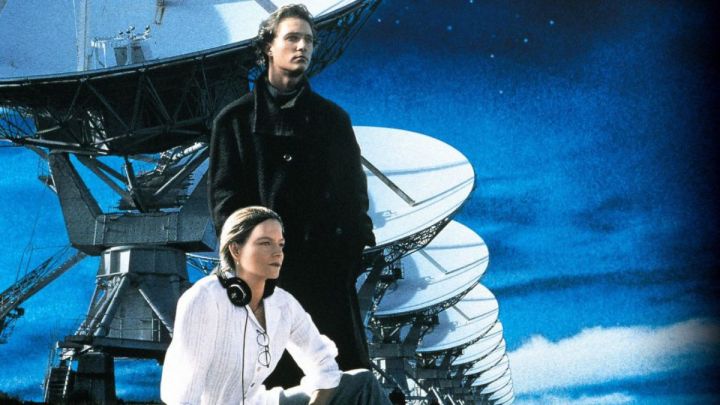The cinematic landscape in 1997 looked very different than today. Jodie Foster was still considered a box-office draw; Matthew McConaughey was just that guy from A Time to Kill; and Robert Zemeckis was still Robert Zemeckis, riding the post-Forrest Gump wave. It was in this distinctive landscape that Contact premiered in the summer of 1997, promising a mind-bending and thought-provoking spectacle for fans of thinking person’s sci-fi.
The film didn’t quite deliver on its promise because while insightful and evocative, it remains distinctively cold and clinical, detached from its human characters in favor of its admittedly weighty themes. Still, time has been kind to Contact; it might never have a place among the all-time best science fiction movies, but it’s a worthy contender. You have to be too cynical or contrarian not to admire the film’s sheer scope and uncompromising ambition. It’s hard to follow and needlessly talky, but it remains an undeniably rewarding viewing experience.
And yet, Contact might be more entertaining for the twists and turns that happened before and after its release. Most films’ releases go smoothly, with maybe a few bumps down the road, but Contact faced an uphill battle from the writing phase to the opening night and for many months after. A collection of controversies, misunderstandings, and even lawsuits, the film’s legacy is as tricky and unexpected as anything that happens in the movie itself.
Bill Clinton said what?

Complaints about a soon-to-be-released film must be a nightmare for any studio. However, extra attention must be paid when said complaints come from the White House. Three days before Contact‘s premiere, the White House issued a letter addressed to Robert Zemeckis condemning the use of footage from two press conferences by then-President Bill Clinton. The film used the heavily-edited clips to support the existence of extraterrestrial beings within the story’s context. In fact, Clinton plays such a meaningful role that Entertainment Weekly cheekily claimed he could snag a Best Supporting Actor nomination.
The letter, in official White House stationary, condemned the use of President Clinton and cautioned against Hollywood’s use of his image. In response, a Warner Bros. spokesperson replied that the studio was “frank and upfront with the White House about this issue.” The studio further claimed they sent the script and a final print from Contact before its July 11 premiere date. In a truly shameless act, they also declared they never sought nor received any clearance from the White House to use Clinton’s image.
Nowadays, it would be unimaginable to think a major studio like Warner Bros. would use an individual’s image without their consent. It’s incredible, even impossible, to conceive that Warner, Zemeckis, and everyone involved in making Contact would have no issues making it seem like Bill Clinton said something he didn’t. Because the film didn’t use an actor to portray Bill Clinton, it was the actual Bill Clinton saying things that seemingly confirmed human contact with extraterrestrial beings.
Of course, one would think audiences would have enough common sense to differentiate between reality and fiction. But common sense is the least common thing in this world, and if a sufficiently unassuming person sees the President of the United States giving a speech and seemingly confirming human contact with extraterrestrial life, could there possibly be any truth to it? And that’s not even mentioning conspiracy theorists and paranoids, those who interpret crop circles and look for lizard people hiding among the crowd.
The controversy opened the door for a debate about the morality of using people’s likeness in motion pictures. In its initial reporting of the incident, Variety claimed copyright and “fair-use” experts feared what technological advancements could mean for the digital recreation of certain people on screen. And while the thought might’ve seemed far-fetched in 1997, we are currently living in that questionable reality. James Dean made headlines 65 years after his death when it was announced a digitally recreated version of him would star in a Vietnam drama called Finding Jack. Peter Cushing also returned to life, 22 years after his passing, for a quick cameo in 2016’s Rogue One.
With the lines between reality and fiction becoming even blurrier, it’s easy to understand why the Clinton incident caused such a stir in 1997’s Hollywood. As it turns out, lawyers’ and experts’ concerns were well-founded, and while their worst fears haven’t exactly come to pass, it’s truly terrifying to think they might materialize sooner rather than later. If only the copyright experts could see us now.
This is CNN

“Jodie Foster may be the star of Contact, but she’s not the one getting all the attention.” Those were the opening lines of a contemporary review for the film, echoing the sentiments of many other critics and fans who were more concerned with Contact‘s questionable ethical practices than with the film itself. The Clinton debacle was controversial enough, but the film also included appearances by numerous CNN broadcasters, including Larry King and Bernard Shaw.
The presence of so many real-life CNN figures sparked a conversation about the ethics of CNN and Warner Bros. — both owned by Time Warner — working in fiction together. The reporters’ participation in Contact was supposed to promote the network during the summer months; however, CNN CEO Tom Johnson declared the decision a mistake, stating it created “the impression that (CNN is) manipulated by Time Warner,” and it “blurs the line.” Others agreed. Eric Ober, former president of CBS News, said it “blurs the line between fact and fiction and erodes the credibility of journalists.” The controversy eventually led to Johnson deciding that any future appearances would need clearance from CNN’s ethics group.
In hindsight, the reaction might seem a tad exaggerated. After all, news anchors cameoing in film and television is not unheard of; a year earlier, many reporters appeared in the summer blockbuster Independence Day. Martin Lewis pops by in The World Is Not Enough, Soledad O’Brien and Anderson Cooper show up in Batman v Superman: Dawn of Justice, and Pat Kiernan is a mainstay in the Marvel Cinematic Universe, having appeared in four films and a few of the Disney+ shows. Hell, Katie Couric once appeared on Glee and danced with Matthew Morrison.
In a way, the CNN scandal gave Contact a weird sense of legitimacy. Because while no one had an issue with a real-life reporter appearing in a ludicrous piece of summer entertainment like The Lost World: Jurassic Park, Zemeckis’ Contact was a serious film based on a Carl Sagan book. It was the thinking person’s entertainment, serious and full of weighty themes, not your average garbage movie or campy action flick — and there were a ton of those in the summer of ’97. Controversy is always good if the project enduring it can weather the storm, and the CNN debacle kept Contact in people’s minds for years after its initial release window. Is all publicity truly good publicity?
Fury road to the finish line

George Miller is one of the most versatile and accomplished film directors in the business. He’s also one of the few genuine auteurs working in modern blockbusters, delivering insightful and evocative pieces that never sacrifice action or spectacle. Miller is behind some of the best films of the 20th and 21st centuries, including Mad Max 2, Babe, and Max Max: Fury Road. As it turns out, Miller could’ve also helmed Contact.
Miller signed on to direct the adaptation of Carl Sagan’s famous novel in 1993 and worked on the project for over a year. It was Miller who first approached Jodie Foster; the director also wanted several revisions of the story, including a side plot about the Pope. Contact was a typical story of studio wants versus creative needs. Warner Bros. wanted it large, grand, and splashy; Sagan wanted to maintain the integrity of his novel while living up to its lofty themes; and Miller wanted a million things, many of which would push Contact past its schedule and budget.
In a 2015 interview with Collider, Miller admitted that he wanted to make a film with less exposition and instead feature characters “experiencing,” He compared his version to Christopher Nolan’s Interstellar and declared he had never seen Zemeckis’ Contact. In a recent interview with Vulture, Foster called Miller’s script “incredibly long” and “crazy,” going so far as to say it reminded her of Eraserhead. Back in 1997, on a cover story for Entertainment Weekly, Foster praised Miller but called him “very naïve about the business,” explaining how he was surprised by Warner’s decision to fire him.
Miller isn’t the only prominent director embroiled in the Contact tangle. In 1996, legendary filmmaker Francis Ford Coppola sued Warner Bros. and Carl Sagan — who had died days earlier — over Contact‘s rights. Coppola claimed that Sagan’s novel was based on a short story they developed for an unproduced 1975 television special, First Contact. Per Coppola’s words, the agreement between the two stated they would share any proceedings from First Contact and any novel Sagan subsequently wrote.
A judge dismissed Coppola’s claim in 1998, claiming that, while Sagan indeed breached some of the terms in the agreement, Coppola waited too long before suing. The director appealed, but the appellate court dismissed his claim on the same grounds. The court further claimed that Coppola didn’t think of suing until 1994, nine years after Contact‘s publication, at a time when he was also pursuing legal action against Warner Bros. over the doomed Pinnochio project; that particular case, although as fascinating and intricate as The Godfather trilogy, is best kept for another day.
The remains of the contact

Twenty-five years after its premiere, Contact remains a fascinating example of the science fiction genre. It might not be 2001: A Space Odyssey, but it was one of the most ambitious films of the ’90s, a passion project that went through many hands and minds without benefitting from any of them. It might’ve done nothing for Jodie Foster’s career, but it gave us plenty of juicy behind-the-scene details and enough drama to support an episode of TMZ.
Furthermore, Contact has a place of honor in the pages of Hollywood’s juiciest behind-the-scenes dramas. Think of Whatever Happened to Baby Jane?, Waterworld, The Island of Dr. Moreau, and Miller’s own Mad Max: Fury Road. These films are pieces of Hollywood history; it’s not about quality with these projects, for the drama surrounding them outweighs anything happening on screen.
If we were to listen to Miller’s words, the Contact we have now pales compared to the Contact we could’ve had. And looking at its convoluted and long backstory, the film’s background might be more interesting than the finished product. However, that’s not an insult towards Contact; on the contrary, it’s a compliment. So what if the how-to is far more entertaining than the film itself? At the end of the day, Contact is still a valuable piece of cinema. Who cares how it got there? At least it did, which is more than many other films can say.




